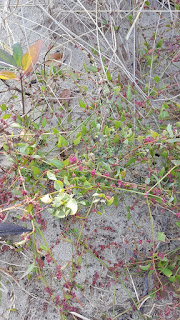The salt marsh scrub along
the bay side of Sandy Hook occurs in tidal
and higher, irregularly flooded habitats. This blog identifies
some of these moderately
halophilic plants, including a few salt
bushes (not grasses or trees in this post) from photos taken at
Horseshoe
Cove and Plum Island.
These pictures – and
over 6 million observations worldwide - have been geolocated and
posted at iNaturalist.org.
You can zoom-in to Horseshoe Cove to see a map of icons representing
groups of species, like plants, birds, fish, shells, etc.
The plant names in
this post are linked to a great website for identifying plants in
maritime habitats like Sandy Hook, “Cape
May Plants – An Identification
Guide” by CapeMayWildlife. NY-NJ-CT
Botany Online has biota lists for many of the parks in our area,
including a plant
list for Sandy Hook.
Common names vary, so use
the Latin scientific name if you want to Google more images.
Horseshoe Cove
After leaving the path
from the salt marsh bridge, walk north towards Battery
Arrowsmith along the wetlands above the beach.
Sea Lavender (Limonium
carolinianum)
The left picture shows the
typical lavender-colored mature plant at the top, and the leafy
sprout at the bottom, covered with some type of white powdery-mildew,
that is a common
Limonium
pest. The picture on the right is what it looks like before it
turns lavender. A lot of these lavenders bloom around the boardwalk
at Spermaceti Cove.
Sea
Blight (Suaeda
maritima)
Look
for both succulent spikelets and seed-like balls along the stems (it
looks a little like spiky ragweed). The technical names for these
parts may be in this link,
along with a nice close-up. Suaeda is Arabic for black salt, which is
the color of its extracted salt after drying (same link). Sea Blight
is a lallation
issue for Sea Bright.
Pickleweed (Salicornia
sp.)
"Fetches
more than $5 a pound at the Berkeley Bowl grocery.” Local
species include Virginia
Glasswort and Common
Glasswort. Lots by Spermaceti boardwalk.
Marsh
Elder (Iva
frutescens)
After
you cross the road from the Horseshoe Cove parking lot, look on the
right (to the north) for an opening in the brush. You will see three
distinct
zones in the salt marsh that is caused
by the frequency and duration of tidal flooding. Marsh Elder is
the hedge in between two grasses: Saltmarsh Cordgrass (Spartina
alterniflora), which is most adapted to living in saline water,
and Saltmeadow Hay (Spartina patens), at the edge of the
semidiurnal
flooding, just below the treeline. The treeline is where a lens of
freshwater (from
rain) floats on the saline groundwater and the maritime forest
begins.
Plum
Island
Besides
these plants, Plum Island also has three salt
bushes. Salt bushes thrive in salt
marshes because they secrete
excess salt to maintain their internal salt balance (they are
also well adapted to deserts). All three species are listed by
NY-NJ-CT Botany
Online for Sandy Hook.
Crested
Orache (Atriplex
mucronata)
Along
the main path across from Parking Lot B, as it curves along the tidal
cove to the north (on the right). Below a long hedge of Marsh Elder.
The picture on the right shows the flower spike and the distinctive
“spiky fruiting bodies”.
Spear-leaved
Orache (Atriplex
prostrata)
Along
the main path across from Parking Lot B, well past where it curves
along the tidal cove to the south (on the left). Note the triangular
leaves.
Fivehorn
smotherweed (Bassia
hyssopifolia)
Same
area as Atriplex mucronata,
as well as further to the northwest along the path. The picture on
the right shows the 5
horns.
These
plants can be found at other locations in Sandy Hook, as well as in
some towns along the Bayshore that still have intact salt marsh
habitat. Log into iNaturalist
and zoom in for exact locations.







